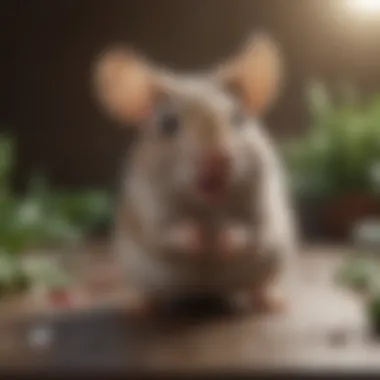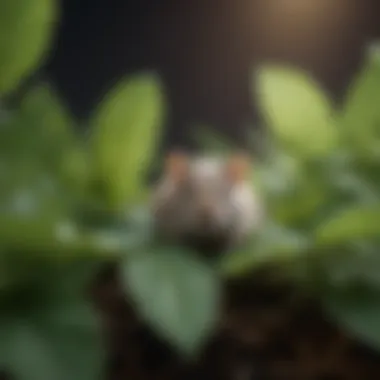Peppermint and Rodents: Exploring the Natural Repellent Potential


Preventive Pest Control Strategies
When it comes to pest control, starting with preventive measures is key to maintaining a pest-free environment. House Exterior Protection is essential to safeguard your home. Sealing cracks and gaps in walls and foundations helps prevent pests from finding their way inside. Clearing debris such as woodpiles and overgrown vegetation eliminates hiding spots for pests. Ensuring a well-maintained yard is also crucial. Regular yard care routines like mowing the lawn and trimming bushes reduce pest harborages. Implementing methods such as removing standing water and keeping outdoor trash bins tightly sealed further discourages pests from entering your living space. Indoor Cleanliness plays a significant role in pest prevention. Expert cleaning tips and techniques involve practicing good sanitation habits, such as storing food in airtight containers and promptly fixing leaky pipes to eliminate water sources that attract pests. Maintaining a pest-resistant indoor environment includes regularly vacuuming carpets and upholstery to remove crumbs and other potential food sources for pests. Garbage Disposal is a vital aspect of pest control. Efficient waste disposal methods, like using sealed trash cans and promptly emptying them, help deter pests looking for food sources. Proper garbage disposal is essential in preventing pest infestations and maintaining a healthy living environment. Other Pest Prevention Strategies encompass innovative ways to further safeguard your home against unwelcome visitors, such as installing door sweeps and using insect screens on windows.
Introduction
The topic of peppermint and rodents is a crucial aspect of pest management that warrants thorough inspection and analysis. In this comprehensive study, the focus is primarily on exploring the relationship between peppermint and rodents, and how the properties of peppermint can serve as a natural repellent against these unwanted intruders. By delving into the scientific evidence behind peppermint's efficacy in deterring rodents, this study aims to shed light on practical applications for effective pest control strategies.
Overview of Peppermint
Botanical Background
The botanical background of peppermint plays a pivotal role in understanding its significance as a natural repellent for rodents. Peppermint, scientifically known as Mentha piperita, is a hybrid mint species that encompasses a unique combination of aromatic compounds and volatile oils, giving it a distinct sharp flavor and scent. These botanical features make peppermint a popular choice for pest control due to its potent odor that can repel rodents effectively. However, it is essential to note that while peppermint's botanical background has valuable repellent properties, its strong scent may also pose challenges in certain environments where sensitivity to strong odors is a concern.
Aromatic Properties
The aromatic properties of peppermint are pivotal in understanding its effectiveness as a natural rodent repellent. Peppermint derives its distinctive aroma from high levels of menthol, menthone, and limonene, among other compounds. These compounds contribute to peppermint's strong odor, which is unappealing to rodents, ultimately deterring them from infesting spaces where peppermint is present. This aromatic profile of peppermint makes it a desirable choice for pest control applications, as it offers a natural and non-toxic alternative to chemical-based repellents. However, the concentrated aromatic properties of peppermint can also be overwhelming in confined spaces, requiring judicious application for optimal results.
Common Uses
Peppermint finds a multitude of common uses beyond its culinary and medicinal applications, particularly in the realm of pest control. Due to its potent scent and natural repellent properties, peppermint is extensively utilized in various forms such as essential oil sprays, peppermint sachets, and even planting peppermint in gardens to deter rodents effectively. The versatility of peppermint in pest control applications makes it a preferred choice for individuals seeking eco-friendly and sustainable solutions for rodent management. However, while peppermint's common uses offer practical and natural rodent deterrent options, it is essential to consider factors such as concentration levels and reapplication frequency to ensure long-lasting efficacy in pest control endeavors.
Rodents in Pest Control
Common Rodent Species
Understanding the biology and behavior of common rodent species is paramount in devising effective pest control strategies. Rodents such as mice, rats, and squirrels are among the most prevalent pests encountered in residential and commercial settings. Their adaptable nature and rapid reproduction rates make them challenging nuisances to eradicate once they infest a property. By delving into the habits and habitats of common rodent species, pest control experts can tailor intervention methods that target specific behaviors and vulnerabilities of these pests, thus enhancing the efficacy of rodent management efforts.


Health Risks Associated
The health risks associated with rodent infestations underscore the critical need for proactive pest control measures. Rodents serve as vectors for various diseases, including hantavirus, salmonellosis, and leptospirosis, posing significant health risks to humans and pets. Moreover, their gnawing habits can damage structures and contaminate food supplies, further amplifying the detrimental consequences of unchecked rodent populations. Addressing the health risks associated with rodent infestations necessitates swift and thorough pest control interventions that prioritize both short-term eradication and long-term prevention of rodent reinfestations.
Conventional Control Methods
Conventional control methods constitute the traditional approach to managing rodent infestations through tactics such as traps, baits, and chemical deterrents. While these methods have been conventionally employed for rodent control, concerns regarding their potential harm to non-target species and the environment have prompted a shift towards more sustainable and eco-friendly alternatives. Integrating technological advancements in pest control, such as ultrasonic repellers and exclusion barriers, offers a modernized approach to rodent management that minimizes ecological impact while effectively addressing rodent infestations. By assessing the advantages and limitations of conventional control methods, pest control practitioners can adopt a comprehensive and holistic approach to rodent management that prioritizes efficacy, safety, and environmental sustainability.
Scientific Insights
In the realm of scientific insights, this article delves deep into the fascinating relationship between peppermint and rodents. It goes beyond the surface to explore the intricate workings of peppermint as a natural repellent for rodents, shedding light on the scientific evidence that underpins its effectiveness in pest control. By dissecting the active compounds present in peppermint and their impact on rodent behavior, this section aims to provide a comprehensive understanding of how peppermint serves as a formidable deterrent against rodents. Through meticulous studies on efficacy, readers will gain valuable insights into the practical applications and potential limitations of utilizing peppermint as a natural repellent in rodent control strategies.
Peppermint as a Natural Repellent
Active Compounds in Peppermint
Unraveling the complex composition of peppermint, this section hones in on the active compounds that set this herb apart as a potent natural repellent. By elucidating the specific aspects of these compounds and their contributions to warding off rodents, readers will grasp the essence of why peppermint stands out as a preferred choice in pest control endeavors. The key characteristic that makes these active compounds exceptional lies in their ability to disrupt rodents' olfactory senses, causing discomfort and deterring them from infesting spaces. While these active compounds boast undeniable benefits, such as their organic nature and sustainable profile, it is crucial to also consider potential drawbacks, such as varying efficacy levels in real-world scenarios.
Impact on Rodent Behavior
Diving into the realm of rodent behavior, this subsection unravels how peppermint influences and modifies their actions. By shedding light on the key characteristic of peppermint's impact on rodent behavior, readers will understand the underlying mechanisms that instigate rodents to avoid environments infused with peppermint. The remarkable feature of peppermint's impact lies in its ability to create an environment intolerable to rodents, steering them away from properties seeking protection. While the advantages of this impact are evident in providing a natural and non-toxic solution for pest management, potential limitations may arise concerning the adaptation of rodents to prolonged exposure to peppermint, leading to habituation over time.
Studies on Efficacy
Grounded in empirical research, this segment delves into the various studies that have assessed peppermint's efficacy as a natural rodent repellent. By highlighting the key characteristics of these studies and their relevance to proving peppermint's effectiveness, readers will gain insight into the scientific rigour supporting peppermint's role in deterring rodents. The unique feature of these efficacy studies lies in their ability to provide quantifiable data on peppermint's repellent properties, offering a glimpse into the potential benefits of integrating this herb into pest control practices. However, it's crucial to acknowledge potential disadvantages, such as the need for continuous application to maintain efficacy levels and the potential environmental impact of prolonged peppermint usage.
Practical Applications


Practical applications play a crucial role in this comprehensive study on the relationship between peppermint and rodents. By exploring the practical aspects of utilizing peppermint for rodent control, readers can gain valuable insights into effective pest management strategies. Understanding the specific methods and products that leverage peppermint's repellent properties is essential for implementing eco-friendly and sustainable pest control solutions.
Peppermint Products for Rodent Control
Essential Oil Sprays
Essential oil sprays represent a key tool in rodent control due to their potent peppermint content. These sprays harness the aromatic properties of peppermint to deter rodents effectively. The key characteristic of essential oil sprays lies in their immediate impact, creating an inhospitable environment for rodents without resorting to harmful chemicals. Their natural composition makes them a popular choice for environmentally conscious individuals seeking non-toxic pest control alternatives. The unique feature of essential oil sprays is their versatile application, which allows for targeted use in specific areas where rodents are a concern, providing a safe and efficient solution for pest management in homes and gardens.
Peppermint Sachets
Peppermint sachets offer a convenient and long-lasting solution for rodent repellent. These sachets are infused with peppermint essential oil, emitting a continuous scent that deters rodents effectively. The key characteristic of peppermint sachets is their sustained release of peppermint essence, providing ongoing protection against rodent infestations. They are a beneficial choice for individuals seeking a passive yet potent rodent control method. The unique feature of peppermint sachets is their ease of use and portability, making them ideal for placing in various locations to create rodent-free zones without the need for frequent reapplication.
Planting Peppermint in Garden
Planting peppermint in the garden serves as a proactive approach to rodent control. The key characteristic of planting peppermint is its dual functionality as a repellent and a versatile herb for culinary use. Peppermint's strong scent acts as a natural deterrent for rodents while enhancing the garden's aesthetics. This beneficial choice not only aids in pest control but also offers a sustainable solution for integrating pest-repelling plants into outdoor spaces. The unique feature of planting peppermint lies in its multifunctionality, providing a renewable source of natural repellent that actively contributes to a harmonious garden ecosystem.
Effectiveness and Limitations
Exploring the effectiveness and limitations of peppermint-based rodent control strategies is essential for understanding their real-world application and potential challenges.
Real-World Case Studies
Real-world case studies offer tangible evidence of the efficacy of peppermint in rodent control scenarios. By showcasing actual scenarios where peppermint products have been successfully used to repel rodents, readers can gain valuable insights into the practical benefits of incorporating peppermint into pest management practices. The key characteristic of real-world case studies is their ability to provide concrete examples of peppermint's effectiveness, translating scientific findings into applicable solutions for pest issues. However, it's essential to consider individual variations in results, as effectiveness may vary based on environmental factors and rodent behavior, indicating the need for a tailored approach to pest control.
Duration of Protection
Understanding the duration of protection offered by peppermint products is crucial for implementing sustainable pest control measures. The key characteristic of duration of protection lies in its ability to determine the longevity of peppermint's repellent effects on rodents. By analyzing the timeline within which peppermint remains effective in deterring rodents, individuals can optimize their pest control strategies and ensure continuous protection against infestations. However, it's important to acknowledge that the duration of protection may vary based on factors such as application method, environmental conditions, and rodent species, necessitating regular monitoring and reapplication to maintain consistent repellent efficacy.


Environmental Considerations
Considering the environmental impact of peppermint-based rodent control methods is fundamental in promoting eco-friendly pest management practices. The key characteristic of environmental considerations is their focus on evaluating the ecological implications of utilizing peppermint products for rodent deterrence. By weighing the benefits of natural repellents against potential environmental hazards posed by synthetic pesticides, individuals can make informed decisions that prioritize sustainability and biodiversity. It's vital to recognize that while peppermint presents a safer alternative to conventional chemical treatments, its environmental considerations extend to factors such as cultivation practices, disposal of residues, and overall ecosystem impacts, highlighting the need for a comprehensive approach to eco-conscious pest control.
Future Research Directions
Research into future directions pertaining to peppermint and rodents is crucial in advancing knowledge and practical applications in pest control strategies. This section focuses on specific elements that can shape the trajectory of research in this field. Understanding how enhancing peppermint formulations can lead to more effective rodent repellent solutions is paramount.
Enhancing Peppermint Formulations
Synthetic Analogues
Synthetic analogues play a pivotal role in the evolution of peppermint-based rodent repellents. Their unique composition mimics natural peppermint compounds while enhancing efficacy and durability. The key characteristic of synthetic analogues lies in their ability to deliver a consistent and potent repellent effect, which is essential for long-term rodent control. By ensuring stability and controlled release of active compounds, synthetic analogues offer a reliable and sustainable choice for peppermint formulations. However, their synthetic nature may raise concerns regarding environmental impact and biodegradability.
Combination with Other Natural Repellents
Combining peppermint with other natural repellents presents a promising approach to synergistically enhance rodent deterrent properties. The key characteristic of this combination lies in the complementary actions of different repellents, creating a broader spectrum of protection against rodents. By leveraging the unique features of various natural repellents, such as enhancing odor complexity and target specificity, this approach improves overall repellent efficacy. While this strategy harnesses the strengths of multiple repellents, challenges may arise in optimizing blends for maximal effectiveness and maintaining formulation stability.
Long-Term Studies
Conducting long-term studies is essential for evaluating the sustained effectiveness and ecological impact of peppermint-based rodent repellents. The key characteristic of long-term studies is the ability to monitor repellent performance over extended periods, capturing nuances in efficacy and potential habituation effects. By observing prolonged exposure outcomes, researchers can identify trends in rodent behavior and repellent response, informing practical pest control strategies. However, conducting long-term studies may require significant resources and rigorous data collection protocols to ensure accuracy and reliability.
Behavioral Studies on Rodents
Response to Varying Concentrations
Studying rodents' response to varying concentrations of peppermint reveals crucial insights into optimal repellent efficacy. The key characteristic of this research aspect lies in determining the dosage range that elicits the strongest repellent effect while minimizing habituation. By exploring rodents' behavior in response to different concentrations, researchers can fine-tune formulations for optimal deterrence. Understanding how rodents perceive and react to varying scent intensities is essential for designing effective pest control solutions. However, balancing potency and longevity poses challenges in finding the optimal concentration that maintains repellent effectiveness.
Long-Term Habituation
Investigating rodents' long-term habituation to peppermint exposure sheds light on the sustainability of rodent repellent solutions over time. The key characteristic of long-term habituation studies is tracking rodents' gradual acclimation to peppermint scents, potentially diminishing repellent efficacy. By discerning habituation patterns, researchers can adapt formulations to mitigate reduced repellent effects and prolong overall effectiveness. Recognizing the timeline and factors influencing habituation is crucial for developing interventions that prolong repellent efficiency. Nonetheless, addressing habituation dynamics requires continuous monitoring and adjustment of repellent formulations.
Interactions with Diet
Exploring rodents' interactions with diet in the context of peppermint exposure unveils additional factors influencing repellent efficacy. The key characteristic of this study area is understanding how dietary preferences may impact rodents' response to peppermint repellents. By investigating the interplay between diet and repellent sensitivity, researchers can enhance targeting strategies and optimize repellent attractiveness. Identifying how diet influences rodents' attraction or aversion to peppermint scents informs tailored pest control approaches. Nonetheless, navigating varied dietary preferences and their effects on repellent efficacy calls for comprehensive experimental designs and meticulous data analysis.



